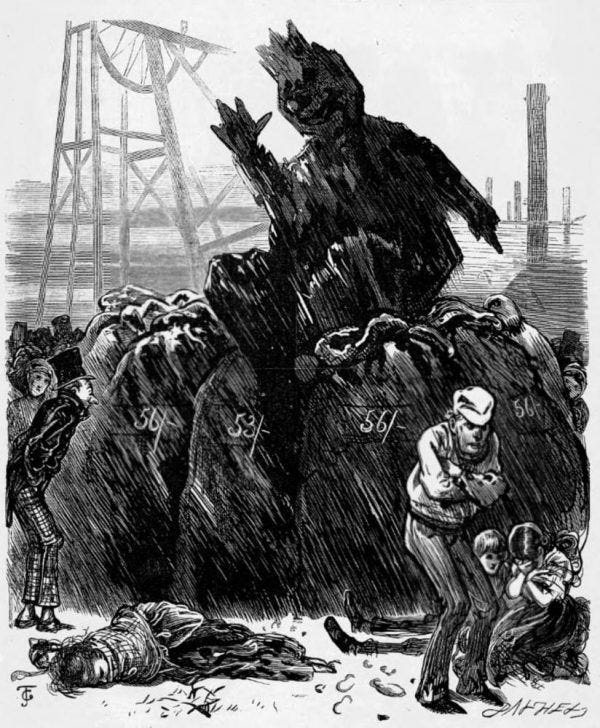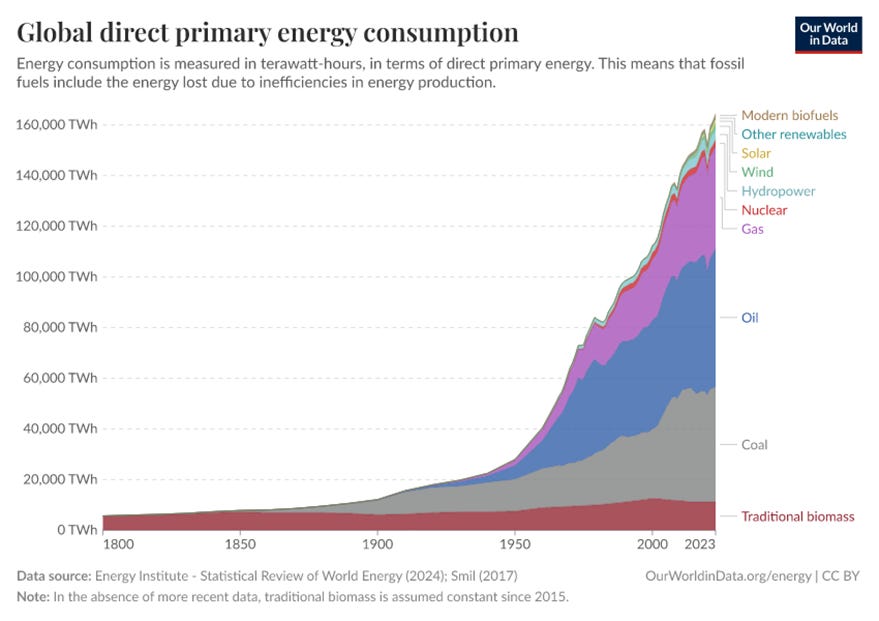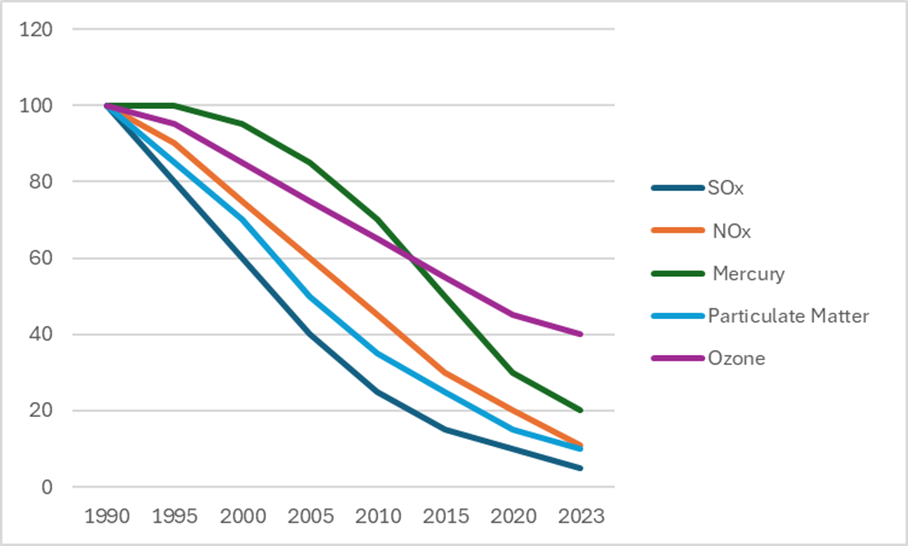Coal powered the Industrial Revolution, transforming societies and raising living standards from the endemic poverty that was humanity’s lot since time immemorial. Its energy density and reliability made it the backbone of progress, first in the West, then globally, long before oil and gas rose to prominence. Despite decades of climate alarmism calling for ‘King Coal’ to be consigned to the ash-heap of history, so to speak, it remains vital, especially in developing nations. It is the backbone of cheap and reliable electricity in populous Asian countries like China, India, Indonesia and Vietnam. In any credible scenario, the importance of coal to the economic growth aspirations of developing countries is not going to appreciably change over the next couple of decades.
Energy analyst David Blackmon remarks in his popular Substack Energy Transition Absurdities:
China and India are building coal plants like it’s 2015 all over again, approving nearly 110 gigawatts (GW) of new coal-fired capacity in 2024 — China with a whopping 94.5 GW and India at 15 GW. That’s the most in a decade, and it’s a loud reminder that energy security trumps climate alarm narratives every time.
China depends on coal for over 60% of its power needs and approved two new plants every week in 2024. The Economic Times celebrated India’s new record of producing over one billion tonnes of coal in the 2023-24 fiscal year, “demonstrating its dedication to energy security and self-reliance”. India relies on coal for nearly three quarters of its electricity supply. Indonesia, the fourth largest coal consumer in the world after China, India and the US, expressed reservations over reducing its reliance on coal power after the US quit the Paris Agreement soon after President Trump took office. Like China, coal supplies over 60% of Indonesia’s electricity needs.
Now, coal is staging a comeback in the United States, the second largest electricity consumer in the world (after China and before India). US power demand is driven by rapid energy-intensive growth in AI digital infrastructure, data centres and crypto mining. Combined with an estimated $2.8 trillion of announced new investments in President Trump’s push for reshoring manufacturing activity since he took office, the expected surge in demand for power will be unprecedented. Despite the availability of fracked natural gas and the potential for a nuclear renaissance, the pace and scale of growth in power demand suggests that coal will play a critical role in America’s prospective energy balance.
In a recent article on coal as the new “bridge fuel”, energy economist Bernard L. Weinstein argues that the lack of construction in new base-load power plants – given the climate-obsessed emphasis on intermittent solar and wind energy and demonisation of fossil fuels during the Obama and Biden administrations – together with the surge in power demand has led to a stretched American power grid. The risks of brownouts and blackouts in various regions in the US have mounted and natural gas can no longer be sold as the sole ‘bridge fuel’ to a promised ‘low carbon’ utopia.
Coal: The Bedrock of Reliable Energy
Coal’s strength lies in its energy density, providing consistent baseload power that intermittent renewables like wind and solar cannot. It’s also abundant and cheap, with US reserves sufficient for over 400 years. This ensures energy security, a geopolitical edge in a world where critical mineral supply chains are contested. As already noted, developing nations understand this.
For three decades, climate alarmists have vilified coal. Germany’s Energiewende (energy transition) shuttered coal plants and went all-in with so-called renewable wind and solar farms. When faced with the prospect of entering the winter of 2022-2023 without sufficient energy supplies (after having shut its nuclear power plants and lost its access to piped Russian natural gas by invoking sanctions against Russia, which was followed by the sabotage of the Nordstream pipeline), the country retreated back to local lignite-fuelled power generation. According to the IEA, Germany’s “significant reversal” drove European coal consumption for power up 9% in 2022.
In the US, the Obama and Biden administrations accelerated coal plant closures beyond the rate at which market forces were displacing coal with natural gas as the preferred fuel, undermining grid reliability. The Supreme Court’s 2009 endangerment finding empowered the Obama EPA to regulate CO2 as a ‘criteria pollutant’ which, by definition, harms human health. It gave government agencies the basis to conduct lawfare on fossil fuels. The Obama administration’s ‘Clean Power Plan’ forced unproven carbon capture technology on coal and natural gas plants to benefit unreliable, intermittent wind and solar electricity.
AI’s Power Hunger and Coal’s Resurgence
According to a report by the International Telecommunication Union (ITU) — the UN agency for digital technologies — and the World Benchmarking Alliance (WBA), digital technologies, especially artificial intelligence and dedicated data centres are reshaping global energy demand. Goldman Sachs Research forecasts global power demand from data centres will increase 50% by 2027 and by as much as 165% by the end of the decade (compared with 2023). A Moody’s report from October 2024 argues that data centres will prolong coal demand as utilities prioritise reliability over decarbonisation goals.
The recent International Energy Agency’s ‘Energy-AI Nexus’ study warns that this surge is straining US grids. Even the IEA, ever the cheerleader for renewables, concedes that intermittent power cannot deliver the required baseload power. Coal, with its dispatchable capacity, is stepping into the breach while the US attempts to catch up on its readiness for new nuclear builds.
President Trump’s energy dominance agenda has embraced this reality. In April 2025, he signed executive orders to keep coal plants open, resume leasing on federal lands and designate coal a “critical mineral” under the Defence Production Act. Energy Secretary Chris Wright emphasised to CNBC’s Money Movers the urgency: “If we want to grow America’s electricity production over the next five or 10 years, we’ve got to stop closing coal plants.” These policies reverse the Obama and Biden administrations’ regulatory assault on fossil fuels, which left grids vulnerable.
Coal-burning generating capacity in the US is down 45% from its 2011 peak. Even more telling, coal generation on a national scale is a shadow of its former self. In the 1980s, coal accounted for almost 60% of all kilowatt-hours produced in the US. In 2024, coal’s share was down to about 15%. Even a year ago, the coal-fired power segment looked like it was on the verge of extinction.
But the retirement of coal plants totalling about 39 gigawatts of power has been postponed, according to data from the National Mining Association. This delay is aimed at maintaining grid reliability as data centres increase their electricity demand, potentially surging 40% by 2039, as forecast by the PJM Interconnection.
This resurgence aligns with America’s strategic goals. Coal ensures grid reliability, supporting AI’s growth and maintaining US technological leadership. It also bolsters energy independence, reducing reliance on foreign energy and countering China’s dominance in manufacturing and increasingly in AI. As Trump proclaimed at the World Economic Forum in January 2025, “We have more coal than anybody,” a strategic asset for American hopes to become ‘great again’.
Trump’s energy counter-revolution upended the narrative of coal’s demise in the US. The coal miners of West Virginia, Wyoming, Kentucky, Pennsylvania and elsewhere have found reprieve. No longer will they be castigated as “deplorables” (Hillary Clinton) or as backcountry people who cling to “guns and religion” (Barack Obama).
Debunking the ‘Dirty Coal’ Myth
The ‘dirty coal’ label is outdated. Modern ultra-supercritical, high-efficiency, low-emission (“HELE”) coal plants drastically cut emissions of sulphur dioxide, nitrogen oxides and particulates. China’s Xuzhou Unit 3, a 320-MW subcritical plant, achieved 43.56% efficiency with ultra-low emissions. India’s 1,320-MW Khargone plant sets similar benchmarks. These technologies make coal a cleaner option, challenging alarmist narratives.
Reductions in Pollutants from Coal Power Plants
The remaining effluent concern — CO2 emissions — is misleading. CO2 is not a pollutant. It is a vital gas for photosynthesis, driving global greening as NASA satellite data confirm. Current CO2 levels are low compared to geological history when higher concentrations supported lush ecosystems.
The Trump administration’s EPA under Lee Zeldin is revisiting the agency’s CO2 endangerment finding. He said: “I’ve been told that reconsidering the 2009 Endangerment Finding would be viewed as an attack on the Holy Grail of the climate change religion. Today’s announcement, without the slightest amount of apology or regret, is about following the constitution and rule of law.” If successful, this could dismantle regulatory barriers to coal, aligning policy with science.
Coal in Trump’s Energy Dominance Agenda
The Trump administration’s energy dominance agenda is pragmatic, well understood by its counterparts in China, India, Russia and elsewhere unafflicted by Europe’s cult of Gaia: energy security is inherent to national security, and cheap, reliable energy ensures economic competitiveness. His executive orders waive burdensome environmental regulations based on politicised science that is weaponised by ‘noble cause’ scientists and their enabling bureaucrats. This approach contrasts with Europe’s failed Net Zero delusions, which are leading to deindustrialisation and soaring energy costs.
The human impact is significant. Coal communities in Pennsylvania and West Virginia stand to gain thousands of jobs. A Pennsylvania coal worker, quoted on X, called Trump’s orders a “sigh of relief”, noting coal’s efficiency for current energy needs. This contrasts with the economic devastation of past plant closures, which gutted livelihoods under the guise of climate progress.
Geopolitically, coal strengthens America’s hand. By leveraging domestic reserves, the US reduces dependence on foreign energy, a critical advantage as China expands its coal-powered manufacturing base and AI infrastructure. Trump’s policies ensure the US remains competitive, powering data centres and reindustrialisation without sacrificing reliability.
Coal is Not a ‘Bridge’ but a Bounteous Resource
Coal’s comeback is a triumph of pragmatism over climate alarmism. Unlike Europe, the US has chosen to embrace fossil fuels while ensuring that both economic prosperity and a pleasant living environment are compatible attributes of successful societies. The developing countries, by climbing the energy ladder of cleaner and more efficient fossil fuel technologies ascended by the now developed countries, can traverse the path of increasing affluence without sacrificing their physical environments.
Calling coal, like natural gas before it, a ‘bridge to the future’ is a misleading idiom. As the magisterial work of energy historian Vaclav Smil has shown in great detail, fossil fuels are not so much ‘bridges’ but nature’s resources that continue giving as techniques of discovery, development and use continually improve. There is no energy transition so much as energy addition, as new technologies evolve and add to the mix. We now have more oil than when we first discovered uses for it despite the billions of barrels consumed, as techniques of exploration and development continuously improve.
The Malthusian syndrome – indelibly etched into the Western sensibility ever since the prognostications of a gloomy 18th century English political economist cast his pessimistic scenarios of scarcity and over-population – must be exorcised. The imagery of ‘bridges’ to an imaginary end-state in the future needs to be cast away. There is a need for more optimistic and realistic scenarios that take into account man’s ingenuity to discover and innovate, when free markets and free minds are allowed unfettered means to spontaneously evolve. The youth in schools and universities should encounter less of eco-doomsters Greta Thunberg and Al Gore and more of Julian Simon and Friedrich von Hayek.
King Coal is far from dead — it’s fuelling America’s future, as it is in much of the rest of the world.







Lovely article, and I agree with your conclusions. But you might want to check that citation of 43.56% thermal efficiency (corresponds to a heat rate of 7833 Btu/kWh), which I think you are saying is for a subcritical coal unit. That seems incredibly low for a subcritical steam-electric coal unit, especially if it has scrubbers for sulfur emissions, baghouse for particulates, etc. as implied by your comment that it has "ultra-low emissions".
Tilak, just a superb article! Many thanks for explicitly stating there will be no energy transition. Even if some energy source comes along which is comparable, or even superior, to hydrocarbon energies, the new energy will simply get added onto mankind's need for ever increasing energy consumption in order for ever increasing human flourishing. And the Climate Cult never addresses the absolutely necessary-to-a-modern-society products which hydrocarbons provide—plastics, petrochemicals, fertilizers, etc.
In no significant way will wind and solar junk energies be a part of the world's energy future. These parasites have only gone, whenever they have gone, by government subsidies, government mandates, and government requirements. The Ruinables of grid wind and grid solar are as much of an indication of government corruption, agency capture, the corruption of "The Science", crony capitalism, and massive propaganda, as anything else.
The real world is demonstrating, to the terrible dismay of the Climate Cult, just how unworkable, just how impoverishing, and how expensive, these junk, dilute, weather dependent Ruinables are. Expect even more shrill cries for society to "cut back", consume less, and be impoverished to "save the planet".
As governments and societies finally wake up to the con, the scam, the fairy tale, that they have been fed, the parasites of grid wind and solar will lose the political tailwinds which forced subsidies and mandates onto societies. It will be the "Green Energies" that become the "stranded assets".
Modern societies were built with, are operated by, and are sustained by, the products and energies of the wonderful, and wondrous, hydrocarbons. The need for plastics, petrochemicals, fertilizers, and energy from hydrocarbons will be even greater a hundred years from now than now. Consumption of natural gas, oil, and coal, will be greater a hundred years from now than now.
And the world really hasn't even scratched the harvesting of methane hydrates, which reserves dwarf all of the natural gas, oil, and coal reserves combined.
https://www.visualcapitalist.com/visualizing-the-scale-of-global-fossil-fuel-production/